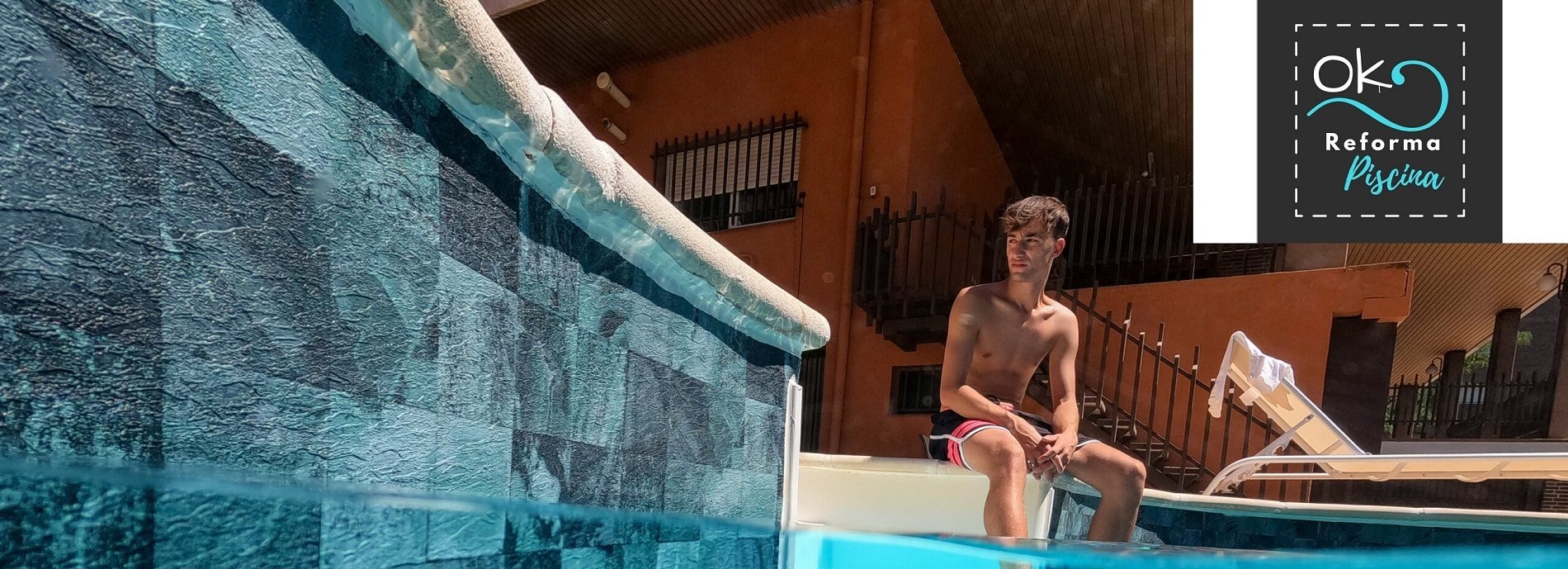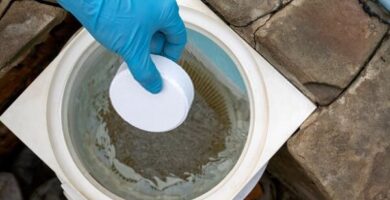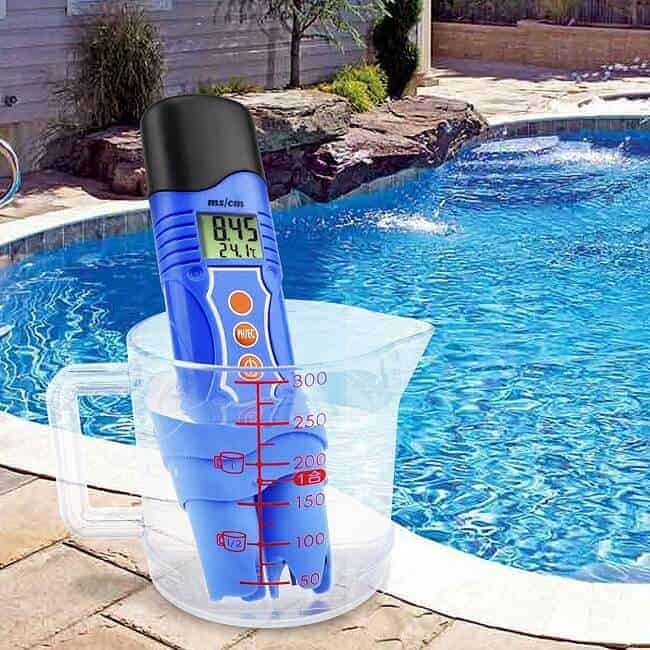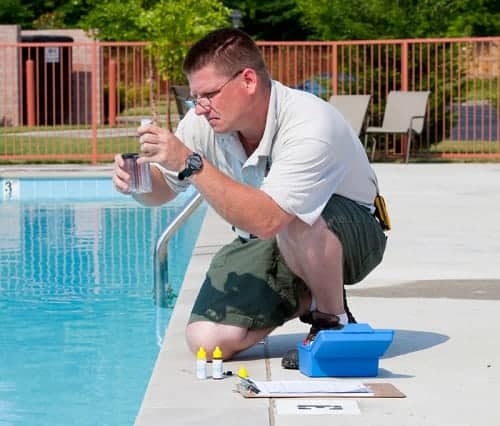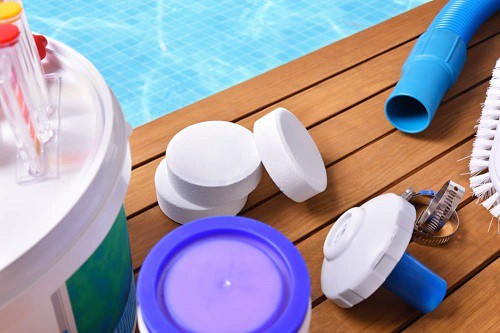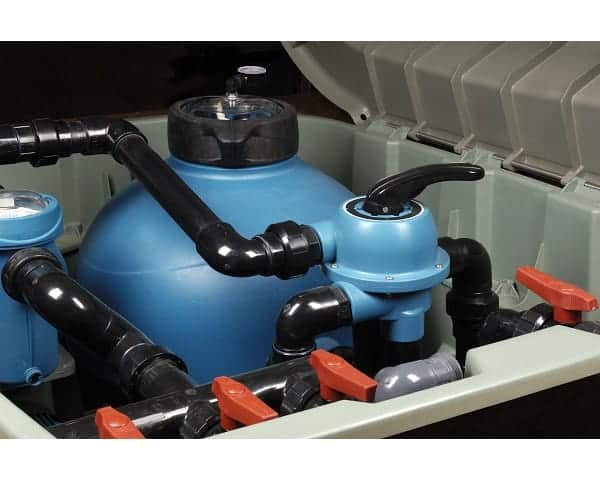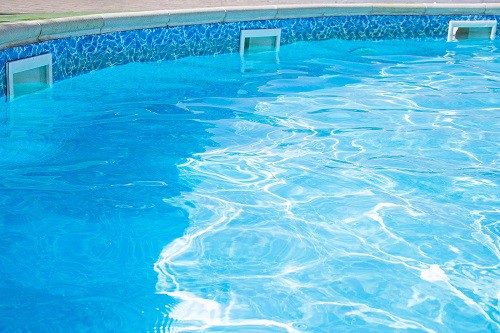
Table of contents of the page
En Ok Pool Reform within pool water maintenance guide We present the article: What is cyanuric acid in swimming pools?.
Cyanuric acid pool what is it

Chemical compound cyanuric acid swimming pool
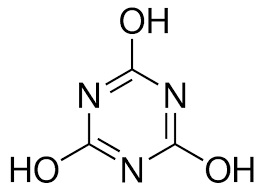
Cyanuric acid formula
What is the formula of isocyanuric acid swimming pool: Chlorinated isocyanurics are weak acid stabilized chlorine compounds (C3H3N3O3 ), of limited solubility in water (chemical additive) that is incorporated to stabilize the chlorine in the water.
What is cyanuric acid (CYA)?
Isocyanuric acid: what is it and what is it for in our pool?
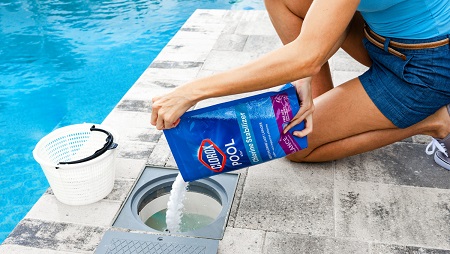
In the pool industry, cyanuric acid is known as a chlorine stabilizer or pool conditioner.
First of all, the pool cyanuric acid stabilizer limits the decomposition of chlorine by the sun's ultraviolet rays, preventing it from being absorbed too quickly and the pool water from running out of disinfectant..
Names given to isocyanuric acid (CYA)
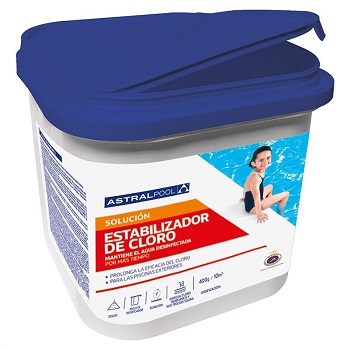
What other ways of calling isocyanuric acid in swimming pools are there?
Likewise, isocyanuric acid (CYA) is also known as: cyanuric acid, isocyanuric acid, CYA, chlorine stabilizer for swimming pools, or conditioner and chlorine protector.
Why is isocyanuric acid needed in swimming pools?


Why is isocyanuric acid needed in the pool?
Thus, cyanuric acid is necessary to stabilize chlorine in water.
- Cyanuric acid is a chemical that improves the life and effectiveness of chlorine in an outdoor pool. This acts in a similar way to a “sunscreen”, but for chlorine, since it prevents it from being diluted and keeps the pool cleaner for a longer time.
Why does your pool need cyanuric acid?
Isocyanuric acids intended for pool water purification

Thus, the isocyanuric acids in the chlorinated pool are stabilized chlorine compounds.They are commonly used as an outdoor pool chlorine stabilizer to disinfect outdoor pools.
Cyanuric acid is a chemical that improves the longevity and effectiveness of chlorine in an outdoor pool. Working almost like a “sunscreen” for chlorine, it protects the chlorine from being diluted and helps keep your pool cleaner for longer.
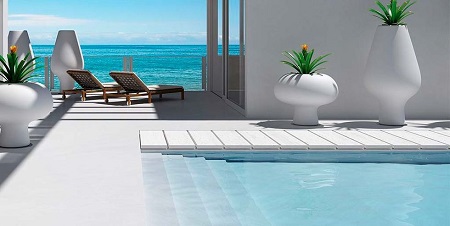
Cyanuric acid in swimming pools, essential for pool maintenance
- The amount of cyanuric acid in your pool greatly affects chlorine's disinfection, oxidation, and algae inhibition rates.
- Studies and research show that ORP levels decrease with the introduction of more cyanuric acid (indicating that the effectiveness of chlorine is decreasing).
- Due to the fact that cyanuric acid does not evaporate or degrade, levels continually build up and pool owners over time are forced to drain their pool.
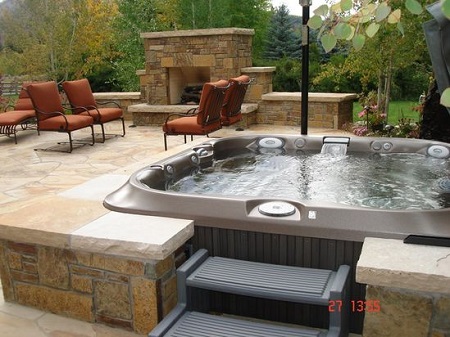
When acid is not necessary
On the other hand, cyanuric acid in swimming pools is not necessary in cases for example:
- Covered pools, jacuzzi, closed pool, bromine treated pools or other disinfection systems (as a result of the chlorine not being destroyed by ultraviolet sunlight).
How does cyanuric acid act in swimming pools?
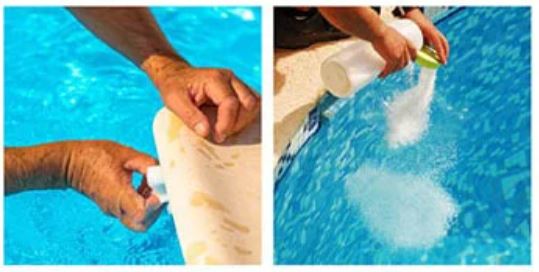
Reaction in pool water of cyanuric acid
Isocyanuric acid (CYA), also called a stabilizer or conditioner, protects chlorine from sunlight.
But CYA is a double-edged sword that causes a dramatic impact on the effectiveness of chlorine and disinfection. It is so important to keep it to a minimum that we decided to make minimal use of CYA our fourth pillar of proactive pool care.
CYA is the chemical substance that when added to pool water forms a weak bond with free chlorine, stabilizing it.

- Firstly, cyanuric acid is a type of chemical compound called triazine, which simply means that it contains three nitrogen atoms and three carbon atoms.
- Other triazines include polyurethane resins, herbicides and disinfectants. Cyanuric acid is a precursor to those, meaning that what you put in your pool is not the same substance as in other uses.
- CYA is the chemical substance that when added to pool water forms a weak bond with free chlorine, stabilizing it, thus reducing losses caused by ultraviolet light from the sun.
What is the isocyanuric acid molecule like?

The isocyanuric acid molecule is a hexagon with alternating nitrogen and carbon atoms. It allows three chlorine molecules to attach to nitrogen, forming a weak nitrogen-chlorine (N-Cl) bond. Because the N-Cl bond is weak, it allows chlorine to release the CYA when it has something to oxidize or kill. However, when bound to CYA, chlorine is protected from sunlight. Isocyanuric acid is a kind of sunscreen for chlorine.
We know that the nitrogen-chlorine (N-Cl) bond is weak because bound chlorine still shows up in a free chlorine test. If the binding were stronger, like that of chloramines and other disinfectant byproducts, chlorine would only show up in a total chlorine test, not free chlorine.
How cyanuric acid pool works
Isocyanuric Acid (parametric value: 75 mg/ L)
Isocyanuric acid is a byproduct formed from cyanuric acid derivatives. It is used in swimming pools that are disinfected with chlorine, and more specifically those that use chlorine tablets or other formats, whose stabilizer is trichloroisocyanuric acid (chloroisocyanurated or organic chlorines) and its function is to prevent the sun's UV rays from destroying the residual chlorine. .
Trichloroisocyanuric acid decomposes slowly, forming hypochlorous acid (residual chlorine) that will act as a disinfectant in the pool, combining with organic matter, and leaving isocyanuric acid as a residue:

Chlorine is temporary by its nature, and therefore more must be dosed as time passes. But unlike what you may believe, every time we dose these pills into the pool, the concentration of isocyanuric acid increases; In this way this acid accumulates, the pH of the water decreases and prevents the hypochlorous acid from acting effectively on the microorganisms.
- Firstly, allude that eIsocyanuric acid associates with a part of the free chlorine, and retains it by stabilizing its molecules and therefore, more than anything, It is essential for any pool that is outdoors, therefore, its function is to prevent it from decomposing with the sun's ultraviolet rays. .
- More than anything, it is Avoid the rapid evaporation of chlorine in the face of ultraviolet rays.
- In short, Let's prevent chlorine from being decomposed so quickly
- .In addition, contributes to lowering the PH level.
- So, with this product for swimming pools we obtain savings in chemical product, and gWe guarantee the disinfection of the water and its own balance,
- Additionally, reduces dedication to pool water treatment.
- Ultimately, it also makes algae outbreaks are much less frequent, since it keeps the chlorine working for longer.
Swimming pool isocyanuric acid: essential with chlorine disinfection
Pool cyanuric acid: mandatory with chlorine treatment

We remember that isocyanuric acid is only needed if chlorine is used, since it does not protect bromine or other disinfectants.
More than anything, It is essential for any pool that is outdoors, therefore, its function is to prevent it from decomposing with the sun's ultraviolet rays. .
And it is only for outdoor pools, since glass, polycarbonates, etc., filter the sun's UV rays, and therefore it is not necessary in covered pools.
On the other hand, remember that cyanuric acid in swimming pools It is also necessary if you are using a salt chlorinator.
Isocyanuric acid (CYA) serves as a protective shield for chlorine against sunlight.
The sun's ultraviolet rays break down chlorine very quickly, creating a problem for outdoor pools.
- Firstly, Chlorine is widely used for its effectiveness in killing and rendering bacteria harmless.
- Similarly, chlorine will kill waterborne germs that swimmers bring into the water, including viruses, bacteria and parasites.
- For this reason, the use of chlorine prevents diseases.
- In parallel, andCyanuric acid, also known as a conditioner or stabilizer, protects chlorine from the sun, but also slows down the chlorine reaction time.
Does this mean you are guaranteed to swim without getting sick at all?
With various types of insects, bacteria and germs in the world, there are some that may have a higher tolerance to chlorine in pool water. In fact, there are even some that are tolerant enough to withstand chlorine for longer periods of time. Therefore, these pool germs can still be problematic for any swimmer.
Need to use ioscyanuric acid with traditional chlorine treatment
Isocyanuric effects on pool chlorine: It is estimated that pool water exposed to the sun loses approximately 35% of chlorine per hour.
- Hypochlorous acid (chlorine) is the most common disinfectant used in swimming pools, due to its great effectiveness as a bactericide.
- However, in the case of outdoor pools, chlorine tends to break down due to the sun's ultraviolet rays and loses its effectiveness as a disinfectant. This fact requires continuous addition of the biocide, in order to maintain adequate disinfection levels.
- But the action of solar radiation on chlorine can be reduced by isocyanuric acid.
- Consequently, pool cyanuric acid is nothing more than a chemical additive that is incorporated to stabilize the hypochlorous acid in the water. In this way, disinfectant consumption is reduced and its effect is longer lasting.
Data on the durability of chlorine in pool water
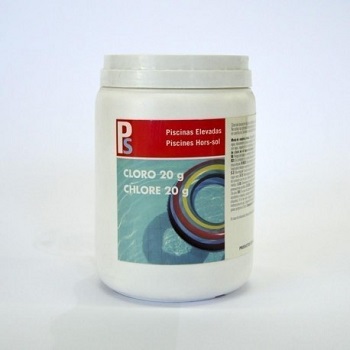
- First of all, Studies show that sunlight can remove chlorine by 75-90% in a matter of two hours.
- The half-life of chlorine, when exposed to direct sunlight, is approximately 45 minutes.
- s. That means half the chlorine disappears in 45 minutes. Another 45 minutes and the other half of the chlorine will be gone. And so on.
- Furthermore, CYA impacts the water in so many ways that we would be seriously harming the pool if we ignored it.
- For this reason, a chlorine stabilizer is needed; Otherwise, you'll be using (and losing) chlorine all day, every day. .
Comparative table of the use of isocyanuric acid together with chlorine

Isocyanuric acid does not disappear
One of the characteristics of isocyanuric acid is that it hardly degrades.
It's good, because this way we don't spend money adding chemicals, but once the optimal level is reached, we don't have to add more.
- If the pool has a high concentration of isocyanuric acid, the only way to lower it is emptying the pool until you have the target level.
- Isocyanuric acid does not evaporate with water (so there is no need to replace it due to evaporation losses).
- It will only have to be replaced when we empty water from the pool (with backwashes, water thrown out by bathers, or when the bottom is cleaned with the pool cleaner and the filter in empty mode).
The danger: chlorine tablets, rapid chlorine and isocyanuric acid
If you have been connecting the dots, you have reached one of the most important conclusions: If you use chlorine tablets, quick chlorine, granulated chlorine, etc. you will be constantly adding isocyanuric acid to the water, and sooner or later the chlorine will lose effectiveness.
Indeed, if at 50 ppm you only have 1% of active chlorine left, with oxidizing power, at higher concentrations the chlorine is completely nullified. And reaching 50 ppm with chlorine tablets is very easy, with 5 Kg you would have already achieved it. From there everything you put into the pool is poison for the same. Chlorine will no longer have an effect, even if you have high chlorine concentrations, and by not disinfecting you will be able to get infections more easily, for example folliculitis, dermatitis, external otitis, diarrhea if you swallow water, etc.
In any pool treated with chlorine powder or tablets it is very normal to see concentrations of 100 ppm, 150 ppm or more of isocyanuric acid. Unless they empty the water every year (which is not only anti-ecological, but also very expensive). A pool with these concentrations should be closed to swimming.
Relationship between active chlorine and isocyanuric acid
As can be seen, the higher the concentration of isocyanuric acid, the higher the level of active chlorine should be, since the latter loses effectiveness. And always without exceeding 50 ppm of isocyanuric acid.
There is no exhaustive rule of the relationship between isocyanuric acid and chlorine, but we could say that the consensus is that the chlorine level should be about 15-20 times lower than that of isocyanuric acid. This means that at 30 ppm of isocyanuric acid it is usually recommended to have 1,5 ppm of chlorine, and at 50 ppm the chlorine level should be approximately 3 ppm.
These chlorine levels are slightly higher than typical levels, because we have already mentioned that isocyanuric acid inhibits the action of active chlorine. But in any case they are not exaggerated levels, since the pool can be used up to a chlorine level of 5 ppm. In any case, a level between 3,5 and 5 ppm of active chlorine (hypochlorous acid) should be punctual; it is not recommended to maintain such high levels permanently.
This "consensus" of 1,5-3 ppm chlorine for cyanuric levels of 30-50 is not a whim, it is supported by organizations and studies.
How often is cyanuric acid added to a pool?
You need CYA for your pool
- As we have already said, the amount of CYA does not disappear, so it stays more or less at the same level unless you have to do a water change or have a big spill or a lot of evaporation.
- However, any dilution as a result of adding water, even rain, will reduce the CYA concentration.
- So surely the only time you will need to add a significant amount of CYA is when you open your pool for the summer.
- After that, if you use stabilized bleach every week, you're adding a little bit of CYA each time. Unless there is a significant addition or loss of water, that is all the CYA you will need to add for the year.
How do I add CYA to a group?
- CYA is a pretty strong acid on its own, so the best way to add it is to dissolve it in a bucket of warm water. Then turn around and pour the solution just inside the edges of the pool. For safety reasons, wear gloves and protective glasses when mixing.
What are some safety precautions when using cyanuric acid?
Do not use CYA for indoor pools.
They warn that it can slow down the effectiveness of chlorine in eliminating pathogens. This could pose a problem at busy indoor water parks, where germs can spread faster than chlorine can reach them. Therefore, for indoor (or even outdoor) pools with a lot of traffic, it might be best not to use CYA.
Safety will come first
However, other experts disagree and say that at least a small amount of CYA is good for indoor pools, especially those that may be surrounded by windows that let in a lot of sunlight. It can also control the degrading effects of chlorine on hair, skin and swimsuits. For those who are sensitive to nitrogen trichloride, CYA reduces the amount that becomes airborne, so it cannot be breathed. But again, this might be better for pools that don't have a lot of traffic and therefore have less pathogen load.
Do not use CYA in jacuzzis
A little CYA won't hurt, but if the levels are too high, warm water can become a runaway breeding ground for all sorts of nasty things. For that small volume of water, any small change in chemistry can be big. So it is best NOT to use the combined stabilizer/chlorine. Stick to pure chemicals, test frequently, and ensure free chlorine remains at high enough levels to kill pathogens at all times.
Cryptosporidium: This microscopic parasite is easily transmitted through water, specifically when someone does a #2 in the pool. Fecal matter can also carry many other pathogens, but crypto is more resistant to chlorine than other pathogens. It can take up to 12 hours for a chlorine level of 20 ppm to kill you. CYA simply slows down that process. That's why many public pools use little or no CYA.
If you have small children or many small children in the pool, keep CYA levels to a minimum. Then, when someone drops a small brown log, it will be easier to clean up the mess.
Isocyanuric acid health

However, if levels of this acid exceed 80 parts per million (ppm), it may do more harm than good.
It is very important to maintain pool cyanuric acid values
- However, this chlorine stabilizer is the reason why if the level of cyanuric acid in swimming pools is too high we will have problems and will not be able to enjoy our pool as usual.
- Test strips are the easiest way to test for cyanuric acid in your pool.
- Cyanuric acid is raised by adding a chlorine stabilizer containing cyanuric acid.
- By diluting or draining your pool to reduce its levels, or using a cyanuric acid reducer, you can easily restore the pool's chemical balance.
- But it must be clarified that in severe cases, the only way to reduce cyanuric acid is by replacing water.
Frequently asked questions about cyanuric acid pool

Questions about isocyanide swimming pool
We resolve all questions regarding isocyanuric acid in swimming pools
What is cyanuric acid in swimming pools:
Therefore, the cyanuric acid (stabilizer) limits the decomposition of chlorine by the sun's ultraviolet rays, preventing it from being absorbed too quickly and the pool water from running out of disinfectant.
Thus, the cyanuric acid It is necessary to stabilize the chlorine in the water.
But if the level is too high we will have problems and we will not be able to enjoy our pool as usual.
Is there any gold name for the cyanuric pool
The reason it is often called a pool conditioner is that it essentially weakens the strength of the chlorine a bit, making it less abrasive to swimmers and pool objects.
Pool isocyanuric acid function
Do I need cyanuric acid in an indoor pool?
Cyanuric acid helps prevent chlorine from being broken down by the sun's UV rays. If you have an indoor pool that is not exposed to sunlight, you do not need to use CYA.
Cyanuric acid does not evaporate like other chemicals and too much CYA in the water can inhibit chlorine's ability as a disinfectant. In fact, the CDC has limited CYA levels to 15 ppm in public pools.
But if you have an indoor pool and you get some UV exposure, and your chlorine levels keep dropping, you may want to consider keeping your CYA low.
How is cyanuric acid produced?
Saying acid will formed by hydrolysis of the sodium and calcium salts it contains, when they add to the water.
However, the acid Hypochlorous tends to decompose, losing its effectiveness as a disinfectant in the presence of the sun's ultraviolet rays.
Is cyanuric acid the same as baking soda?
Baking soda increases the total alkalinity of your pool.
But baking soda does not protect or stabilize chlorine, like CYA.
Is cyanuric acid harmful?
While cyanuric acid is technically an acid, it is very different from other acids (such as muriatic acid).
Cyanuric acid dissolves in water and does not significantly affect pH, alkalinity, or calcium hardness levels.
However, like other pool chemicals, cyanuric acid should be handled with caution. CYA can cause severe burns if it comes into contact with the skin or eyes.
And its fumes can burn your nose or lungs if you inhale them.
Always wear acid-resistant rubber gloves, eye protection, long-sleeved clothing, and handle CYA in a well-ventilated area.
How is Icyanuric acid measured in swimming pools?
First of all, if we do not know what the level of isocyanuric acid we can acquire a specific water analysis test, capable of measure isocyanuric acid, as well as other important values such as chlorine and free chlorine, bromine, pH, hardness and total alkalinity.
What raises cyanuric acid in a pool?
You can raise your cyanuric acid levels by adding a pool conditioner or stabilizer.
How do high levels of cyanuric acid affect a pool?
When cyanuric acid levels are too high, they can affect the effectiveness of your chlorine.
If your chlorine test shows very little or no chlorine right after adding it to the pool, your CYA may be too high.
The only way to reduce CYA levels is to dilute the water by draining and refilling the pool.
What to do if there is excess chlorine in the pool water?
If you can, add new water as it will dilute the compound and avoid pouring a highly chlorinated solution down the drain.
Then, in this same blog we detail what to do with isocyanuric chlorine.
Do pool shock chlorines contain cyanuric acid?
But we recommend using a non-stabilized chlorine shock without CYA.
This ensures that you are not adding unnecessary CYA to your water every time you flush your pool.
We recommend using calcium hypochlorite shock, also known as cal-hypo shock.
Ideal Cyanuric Acid Levels
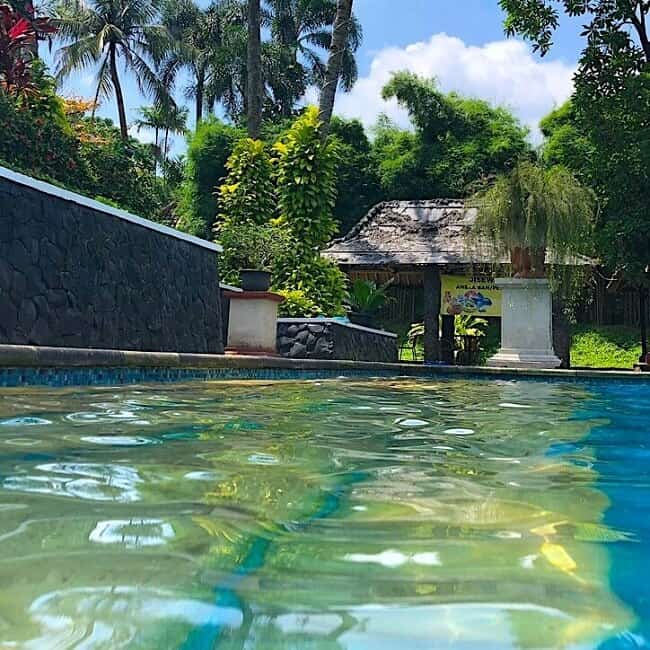
Ideal value cyanuric acid (chloramines)
The optimal concentration of cyanuric acid in swimming pools is between 30 and 50 ppm. Although, the World Health Organization suggests that cyanuric acid levels in swimming pools do not exceed 100 ppm. In Spain, it has been agreed with the Royal Decree 742 / 2013 the recommendation that cyanuric acid in swimming pools be less than 75 ppm.
We recommend keeping your cyanuric acid around 50 ppm. Safety concerns aside, any higher concentration will inhibit chlorine enough to cause algae and bacteria growth.
Remember, more CYA does not necessarily mean more UV protection.
Specifications of the adequate levels of cyanuric acid in swimming pools

Although, the World Health Organization suggests that cyanuric acid levels in swimming pools do not exceed 100 ppm. In Spain, it has been agreed with the Royal Decree 742 / 2013 the recommendation that cyanuric acid in swimming pools be less than 75 ppm.
The conclusion was drawn based on the assumption that children can probably ingest water and thus swallow too much CYA and become ill.
Cyanuric acid levels in hot tubs
Unlike swimming pools, the concern with hot tubs is that the cyanuric acid is too high. For one thing, cyanuric acid protects free chlorine from evaporating from exposure to ultraviolet light. On the other hand, cyanuric acid slows down the rate at which free chlorine disinfects water.
This cushioning effect is inconsequential in swimming pools. However, hot tubs tend to have a much higher concentration of contaminants because they have a much higher concentration of bathers, who also sweat more due to the water temperature. If cyanuric acid levels are too high, they can render free chlorine ineffective against the disinfectant pseudomonas aeruginosa bacteria (hot tub itch).
Reason for using isocyanuric acid in salt pools
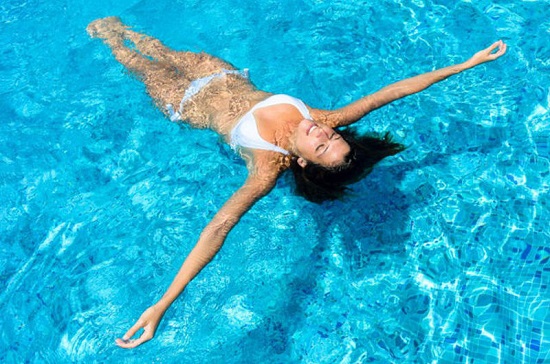
Do I need cyanuric acid in my saltwater pool?
Need for isocyanuric acid in saltwater pools

- Basically, Saltwater pools may also require a stabilizer (cyanuric acid) to help prevent the sun's UV rays from breaking down free chlorine in the pool..
- In view of which, The cyanuric acid level in a saltwater pool should be approximately 60-80ppm.
- Likewise, as a vital factor in the maintenance of the salt pool, they also require that the pH remains around 7,2.
What should be the levels of isocyanuric acid in salt pools?
Isocyanuric acid value in salt pools
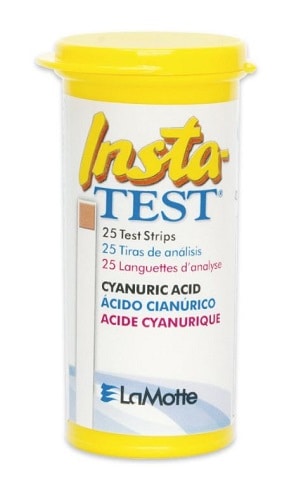
Cyanuric acid level in salt pools: Saltwater pool manufacturers recommend maintaining cyanuric acid levels around 60-80 ppm. And if you live in an area where your pool gets a lot of direct sunlight, you may even consider increasing your cyanuric acid up to 80-100 ppm.
This is a little higher than the 30 to 50 ppm range recommended for non-saltwater pools.
Cyanuric acid levels in salt pools
Why are high levels of cyanuric acid required in salt pools?

- The reason saltwater pools require high levels of cyanuric acid has to do with the production of salt cells themselves, since with a saltwater pool, you are not adding chlorine directly.
As a reminder, salt is sodium hypochlorite which undergoes photolysis by ultraviolet light.
- Therefore, saltwater pools are effectively taxed twice as much by sunlight.
- Firstly, because you are adding salt which is processed into chlorine through a salt water generator [chlorine]
- And secondly, after chlorine is generated from the salt.
Didn't you know you have to use cyanuric acid in a salt pool?
In fact, you should use more than just pools that are treated with traditional chlorine, since top experts recommend 60-80 ppm of cyanuric acid for their salt systems.
Why more CYA or Cyanuric Acid in a saltwater pool?
- Salt system manufacturers want more salt cell performance, without fighting UV degradation. Because cyanuric acid binds to chlorine, residual chlorine can build up faster.
- However, when using high range CYA levels, above 50 ppm, you should also maintain a higher free chlorine level, in the 5 ppm range, to compensate for the effects of cyanuric acid on chlorine.
What effects does the increase in CYA have in salty pools?
Cyanuric acid protects chlorine from the sun, but also restricts chlorine activity; reduces mortality rates and impacts ORP. As a result, many public pools are increasing their minimum HR, for pools treated with cyanuric acid or stabilizer. See a previous blog post on chlorine removal rates in swimming pools.
Water maintenance guide for saltwater pools

Is the salt pool exempt from having green water?

Difference between salt electrolysis (salt chlorination) and chlorine treatment
Simply put, the water chemistry of saltwater pools is not much different than that of chlorine tablet pools. These are the key points of the discussion.
- Keep your pH between 7,4 and 7,6 and total alkalinity between 60 and 80 ppm
- Invest in a sacrificial anode for metal or soft stone equipment
- Test and adjust cyanuric acid according to manufacturer's recommendations
- Finally, link to the guide to water maintenance in swimming pools.
The pH in a saltwater pool
ph-rise-in-a-salt-water-poolIn a saltwater pool, when electrolysis occurs (inside the pipe), the products are hypochlorous acid, which is very acidic (as you might guess), and sodium hydroxide which is very basic. However, the acids and bases created by your salt cell will neutralize each other with very little net pH change.
The increase in pH noted by some salt chlorinator users may be the result of the release of carbon dioxide gases as water is agitated through the salt cell with hydrogen production.
A simpler answer is that trichlor tablets, which have a very low pH, tend to suppress pH levels or reduce them over time and, in their absence, pH levels will naturally increase.
Salt is a corrosive substance, so road salt in winter creates problems for concrete and steel.
Salt levels in a salt pool are usually quite low, below 3500 ppm. But even at low levels, galvanic corrosion can occur on stainless steel equipment (filters, lights, ladders) that is not properly bonded. Passive corrosion can affect the soft, porous stones and concrete around the pool.
sacrificial-anodes-for-salt-poolsWhat to do? One solution is pool equipment made of thermoplastics or bronze, or you can retard galvanic corrosion with a sacrificial anode. Zinc anodes attach to the ladder, pool light or skimmer, and are self-sacrificing, to direct corrosion away from other metal sources with a lower electrochemical potential.
Cyanuric acid in a saltwater pool
Why more CYA? Salt system manufacturers want more salt cell performance, without fighting UV degradation. Because cyanuric acid binds to chlorine, residual chlorine can build up faster.
However, when using high range CYA levels, above 50 ppm, you should also maintain a higher free chlorine level, in the 5 ppm range, to compensate for the effects of cyanuric acid on chlorine.
cyanuric-acid-protects – PM image made by IntheswimDid you not know that you have to use cyanuric acid (Stabilizer or Conditioner) in a salt pool? In fact, you should use more than just pools that chlorinate with Trichlor tablets. Both Hayward and Pentair recommend 60-80 ppm cyanuric acid for their salt systems.
Why more CYA? Salt system manufacturers want more salt cell performance, without fighting UV degradation. Because cyanuric acid binds to chlorine, residual chlorine can build up faster.
However, when using high range CYA levels, above 50 ppm, you should also maintain a higher free chlorine level, in the 5 ppm range, to compensate for the effects of cyanuric acid on chlorine.
Cyanuric acid compensation table for chlorine – Intheswim ImageWhat effects? Cyanuric acid protects chlorine from the sun, but also restricts chlorine activity; reduces mortality rates and impacts ORP. As a result, many public pools are increasing their minimum HR, for pools treated with cyanuric acid or stabilizer. See a previous blog post on chlorine removal rates in swimming pools.
More information about this source text For more information about the translation, the source text is required
Post comments
Side panels
Cyanuric acid: an ignored measurement in swimming pool maintenance
Swimming pool cyanuric acid: the unknown value present in almost all swimming pools
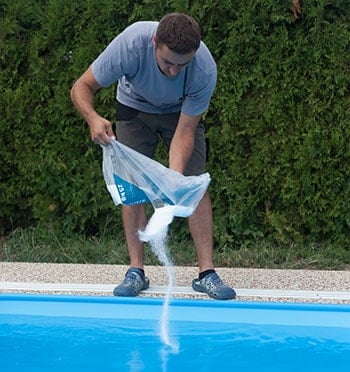
Isocyanuric acid: forgotten pool chemical measurement
It is also worth emphasizing that cyanuric acid in swimming pools, (C3H3N3O3 ) is little known among owners of private pools It is even rarely mentioned in pool specialist stores despite its vital importance.
Swimming pool isocyanuric acid: present in 80% of swimming pools
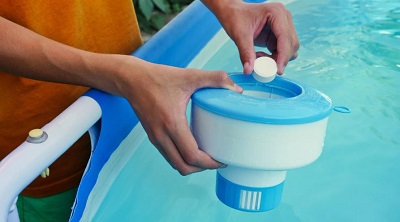
Almost 80% of private swimming pools are disinfected with chlorine tablets made with trichloroisocyanuric acid.
Ideal values in disinfecting pool water
Guide to maintaining pool water
Next, we provide you with the link to the Guide to maintaining pool waterIf you want to enter you will see that on the page in question we cover everything related to routine pool maintenance: Water disinfection, water filtration, pool cleaning and maintenance of the pool liner.
Ideal levels in pool water disinfection
- pH: 7,2-7,6. (related posts: how to increase pool pH y how to lower pool).
- Total chlorine value: 1,5ppm.
- Free chlorine value: 1,0-2,0ppm
- Residual or combined chlorine: 0-0,2ppm
- Ideal pool ORP value (pool redox): 650mv -750mv.
- Cyanuric acid: 0-75ppm
- Pool water hardness: 150-250ppm
- Alkalinity of pool water 125-150ppm
- Pool turbidity (-1.0),
- Pool phosphates (-100 ppb)
- Cyanuric acid pool what is it
- Ideal Cyanuric Acid Levels
- Measure isocyanuric acid
- Why does your pool need cyanuric acid?
- Consequences of cyanuric acid imbalance in swimming pools
- How to adjust cyanuric acid values
- Stop the increase in high cyanuric acid in the pool
- Solution to lower pool cyanuric acid very high
- How to remove cyanuric acid from pool water?
- Check if cyanuric acid has decreased after it has rained
- How to slightly increase cyanuric acid in swimming pools
- How to increase cyanuric acid
Measure isocyanuric acid
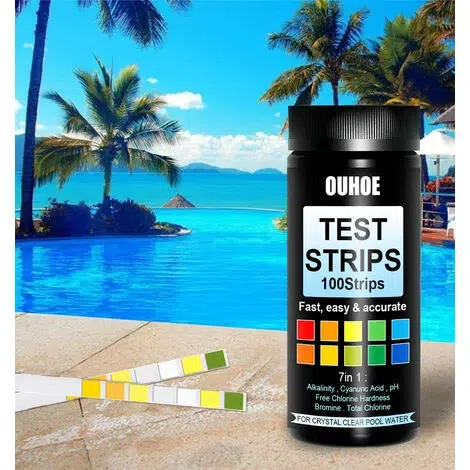
How to test for cyanuric acid
Unlike free chlorine, cyanuric acid levels should remain level from day to day. An exception might be if there is a heavy rain storm during which your pool is left uncovered. Rain will introduce a substantial amount of fresh water into your pool, which can dilute the concentration of cyanuric acid. You should always test your pool chemistry after such an event.
Test strips are the easiest way to test for cyanuric acid. It's important to get test strips that include a cyanuric acid test, especially if you have a hot tub. For more information on why it is important to keep cyanuric acid levels low in hot tubs, see What is the correct cyanuric acid level for pools and hot tubs?
To test your cyanuric acid levels with a test strip, follow the instructions on the test strip case. Typically, you will need to submerge the strip in your pool for a minimum number of seconds. You will then need to wait some time for the water to react with the reagents on the strip. Finally, you will compare the color of the cyanuric acid test on the strip to the range of colors on the test strip package to get an estimate of the amount of cyanuric acid in your pool.
You can use a test kit to test your free chlorine and pH levels. The test kit may also come with a cyanide test. However, cyanuric acid is less critical to measure accurately than free chlorine or pH. It is also not necessary to test it so frequently. Once a week is enough. Therefore, the test strips should be sufficient for most needs of pool owners and pool professionals alike.
Isocyanuric acid meter with test strips
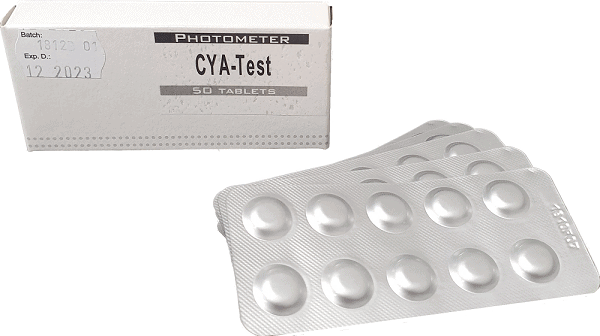
Measure isocyanuric acid in swimming pools with analysis test
Test strips are the easiest way to test for cyanuric acid.
Features of water quality test strips
- It is worth mentioning that water quality test strips They serve both swimming pools and spas as well as jacuzzis.
- Likewise, they are very useful and effective since They provide us in a single sample: the measurement of total chlorine, free chlorine/bromine, pH, total alkalinity, cyanuric acid and total hardness.
- Likewise, the pool and multifunction cyanuric acid test strips They are very easy to use and you test the result very quickly, Depending on the model, the wait ranges between 5-15 seconds.
- And, in short, the pool isocyanuric acid test strip provides a result in a very precise way.
How to use the test strip to measure isocyanuric acid in swimming pools
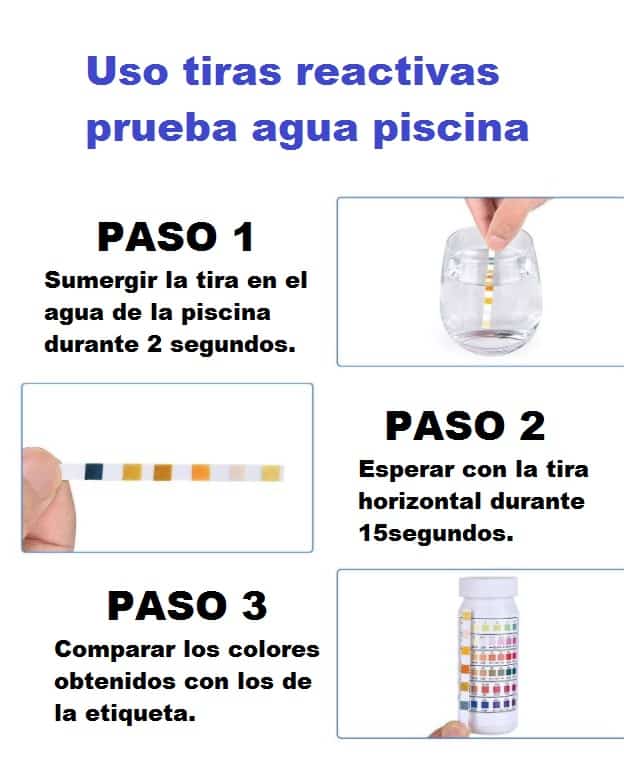
- To test your cyanuric acid levels with a test strip, follow the instructions on the test strip case. Typically, you will need to submerge the strip in your pool for a minimum number of seconds.
- Then, you will have to wait some time for the strip to dry and therefore the water to react with the reagents on the strip.
- You will then compare the color of the cyanuric acid test on the strip to the range of colors on the test strip package to get an estimate of the amount of cyanuric acid in your pool.
- Finally, indicating that the color changes after 2 minutes does not make sense.
How to perform the cyanuric acid test in the pool
Buy Water test strips for cyanuric acid and multifunctional
Pool Analytical Test Strips Price
Measure isocyanuric acid in swimming pools with a photometer
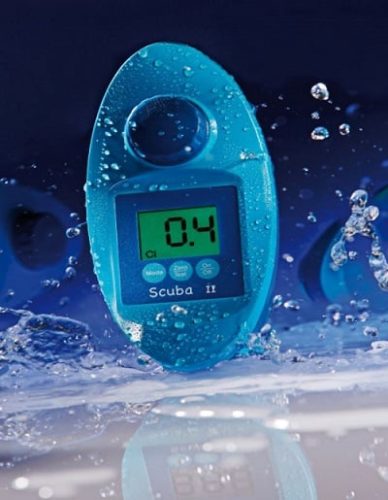
Pool photometer
Pool photometer: Controls cyanuric acid in swimming pools
Thus, To control the levels of cyanuric acid in swimming pools we will use the photometer, which is the best way to control the level of cyanuric acid in swimming pools and all the main water quality parameters with a superior range of accuracy and effectiveness.
The photometers are designed for simplicity, being suitable for all users and providing highly reliable technology.
What the pool photometer allows you to measure
Firstly, it should be noted that pool photometers are very easy to use, handle and control.
And secondly, depending on the model they can provide many types of accurate results of pool water parameters, such as: chlorine, pH, alkalinity, cyanuric acid, bromine, chlorine dioxide, active oxygen (MPS), hydrogen peroxide, ozone, total hardness and calcium hardness.
Features of the Scuba pool photometer
- First of all, the Scuba pool photometer has an ergonomic, waterproof, robust and floating casing.
- Secondly, the product contains a digital screen with an excellent size which allows easy and quick viewing.
- On the other hand, it has an IP-68 insulation degree
- And furthermore, it is planned that it will only be necessary to calibrate the device the first time it is used.
Buy pool photometer
[amazon box=»B0722ZD4G3, B00WRCSWG» ]
scuba ii photometer video tutorial
- Cyanuric acid pool what is it
- Ideal Cyanuric Acid Levels
- Measure isocyanuric acid
- Why does your pool need cyanuric acid?
- Consequences of cyanuric acid imbalance in swimming pools
- How to adjust cyanuric acid values
- Stop the increase in high cyanuric acid in the pool
- Solution to lower pool cyanuric acid very high
- How to remove cyanuric acid from pool water?
- Check if cyanuric acid has decreased after it has rained
- How to slightly increase cyanuric acid in swimming pools
- How to increase cyanuric acid
What causes high cyanuric acid levels?

If you are adding chlorine to water, there is a good chance you are adding cyanuric acid along with it.
Many chlorine products, such as trichlor or dichlor granules or tablets, are known as stabilized chlorine products.
This means they already come with CYA.
Every time you add chlorine to your pool, you are adding cyanuric acid.
On the other hand, unstabilized chlorine, such as liquid chlorine, does not include CYA. You can learn more about the difference between stabilized and unstabilized chlorine here. below this same page
If you need to add CYA to your pool, you can purchase it as a separate product. It is usually called pool stabilizer or pool conditioner (we will recommend a product later).
Monitor the amount of isocyanuric acid in the pool
Just be careful with how much extra cyanuric acid you add to the water. It is very difficult to lower CYA levels if they are too high. And cyanuric acid doesn't evaporate or break down like chlorine, so it will stay in your pool water. It can even remain in your filtration system and pool plaster.
What causes high cyanuric acid?
The most common contributor to high CYA levels is stabilized chlorine. Stabilized chlorine comes with small amounts of CYA, which helps protect your sanitizer from being destroyed by the sun.
Most chlorine tablets or chlorine granules are made with stabilized dichlor and trichlor. So if you add one pound of trichlor chlorine to a 10,000 gallon pool, you can increase the CYA level by 6 ppm. On the other hand, calcium hypochlorite chlorine (cal-hypo), lithium hypochlorite chlorine, and liquid bleach are not stabilized. These will not increase your CYA levels.
As you add stabilized chlorine to water, cyanuric acid levels can build up over time, even as chlorine levels fluctuate up and down. That's because as the water evaporates from the pool, the cyanuric acid remains in the water. So while you're trying to reduce your cyanuric acid levels, stop adding stabilized chlorine.
However, not everyone should be concerned about high CYA levels. If you are a pool owner who drains and refills your pool every year or if you have an indoor pool, you probably don't have to worry about cyanuric acid buildup. But if you have an outdoor pool that stays open year-round and doesn't get much rain, you'll need to monitor your CYA levels.
What happens if the CYA level is too high?
If you find the CYA level is too high, look at the type of chlorine you are adding. If it is stabilized chlorine, it also contains CYA. But they are all labeled differently, so sometimes it's hard to tell. Look on the ingredients label. If you see one of these chemicals, you know it contains CYA:
trichloroisocyanurate
sodium dichloroisocyanurate
potassium dichloroisocyanurate
You should check the chemical levels in your pool
What you will need to do now is switch to CYA-free bleach to prevent levels from rising. If you make the switch and find that the CYA is still a little too high, allow it to splash out a bit and evaporate, then fill the pool with fresh water to dilute the CYA levels.
If the CYA is very high, you may need to drain your pool and refill it. But always test the CYA after a refill before adding more. This is because CYA can remain in the pool's filtration system, as well as in gypsum and calcium scale. And what's left over may be as much or even more than you need.
Consequences of cyanuric acid imbalance in swimming pools

High cyanuric acid effects in swimming pool

Cyanuric acid must remain at adequate levels
Control the ideal levels of cyanuric acid in a swimming pool
At a health level, it is established that cyanuric levels in a swimming pool cannot exceed 100 ppm to prevent gastrointestinal diseases, skin rashes and other diseases. Risk value
Although cyanuric acid offers a low level of toxicity without any serious health problems, Having high levels of this chemical in a pool puts people at risk due to the decreased ability of chlorine to kill bacteria and viruses.
Despite these ongoing problems, the industry has never found a cost-effective solution and environmentally safe way to remedy this problem.
However, cyanuric acid also makes free chlorine less active, reducing its disinfecting effect. At a cyanuric acid concentration above 70 mg/l, free chlorine will no longer disinfect at all. Extreme concentrations can even produce green water!
HARMFUL high values cyanuric acid
RECOMMENDATION: If isocyanuric acid in swimming pools is above 75 ppm, we should not bathe in it and close the pool.
As an example: From 50 ppm value of isocyanuric acid in the pool water, the effect of chlorine is 1% (the effect of chlorine has been blocked and does not disinfect).
What problems can appear with high levels of Cyanuric Acid?
- Chlorine is dissolved by the sun, but stabilizer (cyanuric acid) does not decompose and remains in the water.
- The excess of cyanuric acid It blocks the disinfection capacity of chlorine and our pool will not be disinfected, even if we continue treating it as always.
- high levels of cyanuric acid lead to algae growth in the pool water.
- The high level of this stabilizer increases the toxicity of the water and, according to the World Health Organization, can harm health.
Consequences of high cyanuric acid swimming pool
And, as we have been saying, high cyanuric acid pool
- High levels of this chemical will also damage plaster surfaces. from the pool.
- They will even become ineffective against the growth of a dangerous microorganism called Cryptosporidium parvum (a chlorine-resistant organism known to cause gastrointestinal illness)
- They block chlorine disinfection treatmentTherefore, even if we continue administering biocide tablets on a regular basis, we will not obtain correct disinfection.
- Increase the toxicity of water and becomes very harmful to health caused by inhalation, dermal route or ingestion, such as: irritation, itching or pain.
- Finally, when the substance is ingested in large quantities can affect the kidney, leading to alterations in kidney tissue.
Remove cyanuric acid from pool water
The cyanuric acid in the pool water is not eliminated, you must renew part of the water or empty it completely (depending on the saturation level of the pool).
What role does high cyanuric acid play with chlorine in the pool?
Cyanuric acid is an essential chemical for maintaining chlorine
Despite the great lack of knowledge of this value of pool water, cyanuric acid in swimming pools is still a essential element in pool maintenance.
Cyanuric acid is an essential chemical to keep chlorine working as it should to clean and disinfect your pool.
As an aside, the best thing about cyanuric acid is that it has little effect on alkalinity, calcium hardness, or pH levels.
Find the balance between chlorine and cyanuric acid in the pool
However, In the relationship between chlorine and isocyanuric acid, a correct balance must be maintained, Since, unlike chlorine, isocyanuric acid does not degrade in the sun and its levels in water increase over time.
Chlorine over time induces a high pool cyanuric acid
WARNING: If you use chlorine tablets, quick chlorine, granulated chlorine, etc. you will be constantly adding cyanuric acid to swimming pools, and sooner or later the chlorine will lose effectiveness.
How does cyanuric acid act with chlorine?

Once the chlorine in your pool water has been transformed into sodium hypochlorite ions, CYA binds to those ions, preventing them from breaking down when exposed to UV rays.
This is how it preserves free chlorine and allows it to destroy bacteria three to five times more than it would without cyanuric acid.
That extra time is especially important because at the same time that CYA stabilizes chlorine, the binding between cyanuric acid and sodium hypochlorite ions also makes chlorine a little more difficult.
Therefore, without cyanuric acid in swimming pools, in one hour only 65% of the chlorine that we evoke in the pool would remain.
Why the presence of isocyanuric acid in pool water increases over time
Cyanuric acid in swimming pools: common problem in pools that are disinfected with chlorine
The presence of isocyanuric acid in the pool water increases as the water recirculates through the system, despite the fact that some of the water is renewed.
Thus, With chemical disinfection systems, excess cyanuric acid in swimming pools will be practically inevitable. since the dosage is constant and is increasing.
This is because if the levels of this substance are too high, the effectiveness of free chlorine is blocked and the disinfection power of chlorine is reduced or delayed.
So, every time we dose pills to the pool, the concentration of isocyanuric acid increases and accumulates, while hypochlorous acid decreases and loses bactericidal effectiveness on microorganisms.
In this way, cyanuric acid in swimming pools is a common problem in chlorinated pools; because pool chemicals use the addition of this component to reduce microorganisms.
And, furthermore, due to his lack of knowledge and monitoring of his values, it is necessary to emphasize that he becomes the frequent setback in pools that are disinfected with chlorine and that they do not get the ideal water due to their forgetfulness.
Low cyanuric acid effects in swimming pools

Pools with very low or no CYA will have a significant chlorine demand
Low cyanuric acid in swimming pool It is considered when the value is less than 30 ppm, the chlorine will be consumed quickly and will not perform its disinfectant function.
Pools with very low or no CYA will have a significant demand for chlorine, plus the chlorine is It will consume quickly and will not perform its disinfectant function.
Therefore, ultraviolet rays destroy unstabilized chlorine very quickly and therefore Your pool will be exposed to contaminants (unless you continually add more chlorine).
How to adjust cyanuric acid values

Cyanuric acid parameters above 100 ppm
Drain and refill your pool if you have cyanuric levels above 100 ppm
- Drain and refill your pool if it has cyanuric levels above 100 ppm.
- If your cyanuric acid levels are too high, the easiest solution is to completely drain the pool and fill it with fresh water.
- Use a submersible sump pump to drain your pool completely.
- Take advantage of your empty pool and clean it well.
- Use a calcium, lime and rust remover to clean calcium or scale rings.
- Finally, we indicate the page with the processes to lower isocyanuric acid in the pool.
Indicative cyanuric acid above 80 ppm
Dilute your pool water if levels are above 80 ppm
- Dilute your pool water if levels are above 80 ppm.
- The easiest way to reduce cyanuric acid levels in your pool is to simply dilute the water.
- Partially drain your pool at the same percentage that you want to reduce your cyanuric levels.
- Calculate the percentage by which you want to reduce the level of cyanuric acid and remove approximately the same percentage of water from your pool.
- It is easier to add cyanuric acid to the pool than to remove it, so it is best to overcompensate and dilute the water more than you think you need.
- Finally, link with the processes to lower isocyanuric acid in the pool.
Cyanuric acid index less than 30 ppm
If the values are less than 30ppm: add cyanuric acid

If we find that the values are lower than 30ppm: the solution is to increase the ppm by adding cyanuric acid, we provide you with the address of the specific page: increase cyanuric acid in swimming pools
Tips for use to add any product to the pool
General preliminary procedures before adding product to the pool
To begin with, as a reminder, remember that it is very important to have a routine of checking the water values at least weekly.
And, obviously, before adjusting any type of value in the water we must know exactly how it is.
Review the values of the pool and corroborate the quantities to be integrated according to the product label itself.
Especially, make reference to the fact that the portions are always subject and must be varied depending on multiple factors; the most important: according to the manufacturer of the product (always check the label!), the weather, pool characteristics, etc.
Never pour pool cyanuric acid directly into the glass and you especially have to be very careful if your pool is lined with a liner.
Equally, When we add chemical product and while the values are adjusted, no one can bathe!!!
- Cyanuric acid pool what is it
- Ideal Cyanuric Acid Levels
- Measure isocyanuric acid
- Why does your pool need cyanuric acid?
- Consequences of cyanuric acid imbalance in swimming pools
- How to adjust cyanuric acid values
- Stop the increase in high cyanuric acid in the pool
- Solution to lower pool cyanuric acid very high
- How to remove cyanuric acid from pool water?
- Check if cyanuric acid has decreased after it has rained
- How to slightly increase cyanuric acid in swimming pools
- How to increase cyanuric acid
Tips to Prevent High Cyanuric Acid

What can be done so that there is no over-stabilization?
Preventive recommendations to avoid overstabilization in the pool
- Se recommended make a washed once a week and change the sand or filter crystals every 4-6 years, and also put new water 3-5% each week.
- On the other hand, it can be used other disinfectants as tablets bromine, liquid chlorine hydrochloric, active oxygen, ozone systems, UV lamps, disinfection with magnesium or salt systems (salt electrolysis), which do not contain cyanuric acid (stabilizer).
- It is not necessary to put chlorine with cyanuric acid/stabilizer in indoor pools, jacuzzi, indoor pool, pools treated with bromine or other disinfection systems because the chlorine will not be destroyed by UV rays.
Stop the increase in high cyanuric acid in the pool
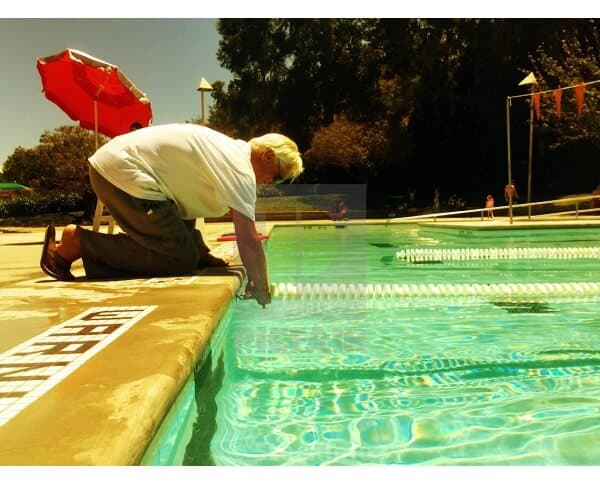
1st tip to slow down high cyanuric acid in the pool: regular check of the pool water status
1st STOP pool high cyanuric acid: Routine control of pool water values
Routine and constant monitoring of the pool is the key to pool water in perfect condition.
To begin with, as a reminder, remember that it is very important to have a habit of checking the water values at least weekly.
And, obviously, before adjusting any type of value in the water we must know exactly how it is.
essential to maintain The ideal value of cyanuric acid in swimming pools: constant chlorine registration
Generally speaking, the chlorine level should be about 15-20 times lower than that of isocyanuric acid, so we must:
- Maintain the level of 2 ppm of Free Chlorine in the pool.
- Ideally, free chlorine should be between 1 ppm and 3 ppm. When using cyanuric acid, try to keep free chlorine levels at 7.5 percent of the CYA level. That means that if your pool has 50 ppm cyanuric acid, you'll need to keep the free chlorine at 3 ppm (the ideal level in any case) to effectively disinfect and keep algae at bay.
Inspection of other values to get rid of high cyanuric acid pool
- And, check that the pH value is between 7,2-7,4. Below, in case you need it, we indicate the tickets for how to lower pool ph y how to increase pool ph.
- Alkalinity between 80-150
- There cannot be any algae in the pool water.
- Copper values in water less than 0,2ppm
2nd tip to slow down high cyanuric acid in the pool: prevent over-stabilization
2nd STOP high cyanuric acid pool: Avoid overstabilization
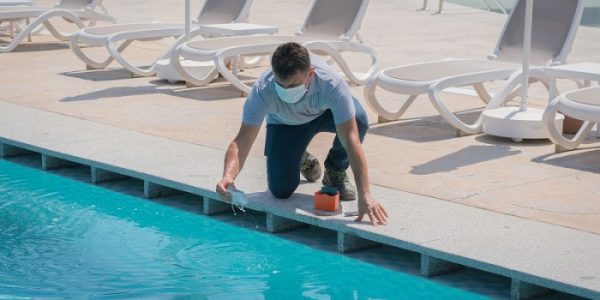
Check the chemicals you consume to prevent overstabilization
How the pool becomes overstabilized
Basically, this occurs when there is excess acid in the pool which occurs in two ways:
- The first is by adding cyanuric acid ourselves (this is the case of pools that use unstabilized chlorine)
- Secondly, when we use stabilized parrot, such as: dichloro and trichloro.
Get into the habit of reviewing the CYA every week, this way you will be able to avoid excessive stabilization.
Cyanuric acid persists in water
At the commemorative level, As the water evaporates and the chlorine is depleted, the cyanuric acid resists the water, and simply builds up.
Check the label of the chlorine we are using
Don't rely on Multi-Action Tablets

Multi-action tablets contain a large portion of cyanuric acid
NOT RECOMMENDED: Although, you should consider that if you use, the famous multi-action tablets (we advise against them!!), You will be adding cyanuric acid to your pool on a constant basis.
PFor each tablet that is added of trichlorpo or mulkthiactions, it increases quickly a lot of Agglomerated concentration of isocyanuric acid can accumulate and therefore the disinfection capacity of the pool decreases considerably.
How to control isocyanuric acid in the pool
Video tutorial how to control isocyanuric acid in the pool
Unstabilized chlorine to stop high pool cyanuric acid
Pool treatment with unstabilized chlorine
Unstabilized chlorine is simply chlorine that has not had cyanuric acid added, so it will not saturate the pool.
This means it dissipates more quickly, you won't get as much disinfecting power, and you'll have to add more bleach more frequently. So if you are vulnerable to the sun,
Eventually, you can consult our page: Pool maintenance with stabilized chlorine vs non-stabilized chlorine
Problem with non-stabilized disinfectants
Unstabilized disinfectants require a lot of attention and consistency because they dissolve quickly, so the time spent treating water will intensify.
Buy unstabilized chlorine
Price of non-stabilized chlorine for swimming pools
[amazon box=»B00IN6OR2A, B07N41CJ24, B07CLBXTMJ» ]
Complement the non-stabilized chlorine pool treatment with chlorine stabilizer
In those cases where we need to raise the cyanuric acid by more than 10ppm and/or we use unstabilized chlorine, we will proceed to add pool stabilizer.
Buy recommended chlorine stabilizer
Chlorine stabilizer price for swimming pools
[amazon box=»B07DQTPW3J, B07DHPBQZP, B08BG61H2G, B08LZKCB26″ ]
- Cyanuric acid pool what is it
- Ideal Cyanuric Acid Levels
- Measure isocyanuric acid
- Why does your pool need cyanuric acid?
- Consequences of cyanuric acid imbalance in swimming pools
- How to adjust cyanuric acid values
- Stop the increase in high cyanuric acid in the pool
- Solution to lower pool cyanuric acid very high
- How to remove cyanuric acid from pool water?
- Check if cyanuric acid has decreased after it has rained
- How to slightly increase cyanuric acid in swimming pools
- How to increase cyanuric acid
Solution to lower pool cyanuric acid very high
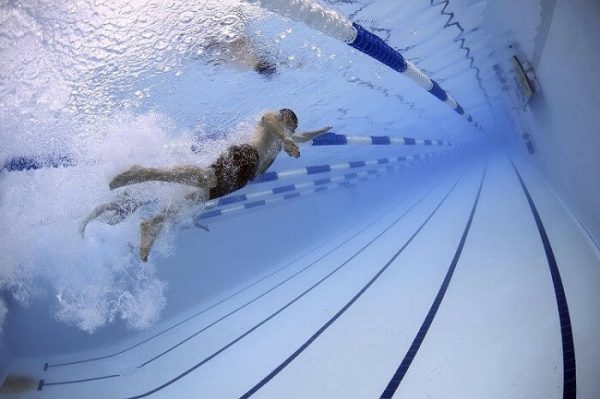
In cases of extremely high amounts of acid, empty the pool
Cyanuric acid parameters above 100 ppm
Drain and refill your pool if you have cyanuric levels above 100 ppm
- Drain and refill your pool if it has cyanuric levels above 100 ppm.
- If your cyanuric acid levels are too high, the easiest solution is to completely drain the pool and fill it with fresh water.
- Use a submersible sump pump to drain your pool completely.
- Take advantage of your empty pool and clean it well.
- Use a calcium, lime and rust remover to clean calcium or scale rings.
Indicative cyanuric acid above 80 ppm
Dilute your pool water if levels are above 80 ppm
- Dilute your pool water if levels are above 80 ppm.
- The easiest way to reduce cyanuric acid levels in your pool is to simply dilute the water.
- Partially drain your pool at the same percentage that you want to reduce your cyanuric levels.
- Calculate the percentage by which you want to reduce the level of cyanuric acid and remove approximately the same percentage of water from your pool.
- It is easier to add cyanuric acid to the pool than to remove it, so it is best to overcompensate and dilute the water more than you think you need.
Method 1how to lower cyanuric acid in the pool
Lower pool cyanuric acid with rain
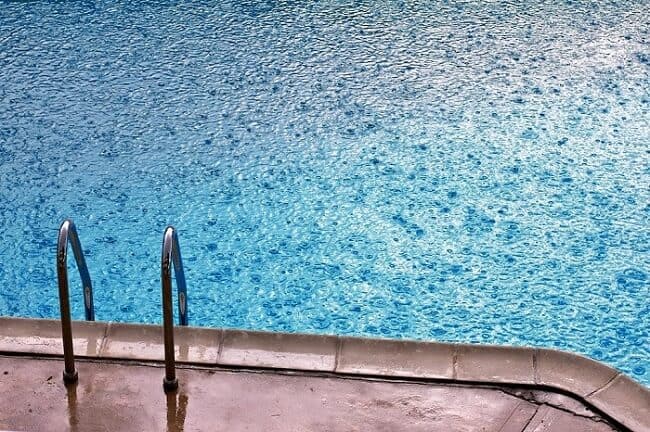
Heavy rains decrease cyanuric acid
First of all, recapitulate that the Cyanuric acid does not evaporate or eliminate itself, however, the saturation level of the water will decrease slightly with the addition of rainwater., which obviously does not contain cyanuric acid stabilizer and will consequently break down the CYA levels in the pool.
Lower cyanuroic acid pool with rain
Technique to reduce cyanuric acid in the pool with rain
The procedure is to drain and refill with rainwater.,
Amount necessary to reduce cyanuric acid in the pool with rain
Primarily, we must renew the pool water in the same proportion of the percentage that we have extra according to the excess level of cyanuric acid present.
In essence, if, for example, we have excess acid values of 5%, then you must eliminate approximately 5% of the water from the pool and wait for the rain to occupy this volume.
Method 2 how to lower isocyanuric acid in swimming pools
Lower the cyanuric acid in the pool by emptying or replacing part of the water

Solve the problem by emptying it partially or completely?
Although how to lower cyanuric acid in the pool will depend on each case, point out that if the pool has a high concentration of isocyanuric acid, the only way to lower it is by emptying the pool.
In the case of obtaining high cyanuric acid levels in swimming pools, is very difficult to reduce since it is degraded very slowly. So the best alternative will be empty the pool and renew the water.
The resolution of the water release will depend on the present values of cyanuric acid.
Mostly as we have said before, the verdict will be executed according to:
- AFirst of all, You must replace all the water in the pool if you maintain cyanuric levels above 0 100ppm.
- or to the contrary, Partially replace and dilute your pool water if levels are above 80 ppm
1st STEP Lower the cyanuric acid in the pool: empty it
How to empty the pool with a pump to drain submersible pool
Actions to empty the pool with a pump
- The first step is to locate your sewer drain pipe.
- Next, connect it to the pump with a hose.
- Next, verify that the hydrostatic valve is turned on.
- Next, place the pump hose in the deepest section of the pool.
- Then, carefully empty the water in case something unforeseen arises.
- If you have a fiberglass pool, never try to empty it, as they are designed to be constantly filled with water. Call a specialist to drain your fiberglass pool.
- Finally, we provide you with the link to our specific page about How to empty a pool: resolve all your doubts about how to empty the pool, when to empty it, how...
Lower pool cyanuric acid by emptying it with an Einhell submersible pool pump
Buy Submersible Pump to empty pool
Submersible pump to empty pool price
[amazon box=»B073Y8H3LC, B075R7SH15, B075R7SH15, B01MA6KH9J, B00FAMEG4E, B00B18KAEG» grid=»2″ ]
2nd STEP Lower the cyanuric acid in the pool: empty it
Fill the pool with clean water

Actions to fill the pool with a hose
- Logically, once your pool has been partially or completely drained, you can begin filling it with clean water.
- For other pstyr, or more garden hoses at the bottom of your pool and turn them on.
- Monitor the pool while it is filling to prevent it from overflowing. The water level should be approximately halfway up the pool skimmer.
3nd STEP Lower the cyanuric acid in the pool: empty it
Filter pool water
Next, you have to wait for a filter cycle until all the pool water has been filtered (normally it takes between 4-6 hours depending on the equipment).
4nd STEP Lower the cyanuric acid in the pool: empty it
Check water values

- Next, check the pH (7,2-7,4), chlorine (2-3ppm) and cyanuric acid levels in your pool (30 and 50 ppm).[
- If it happens that they are not correct, you must proceed to modify them.
5nd STEP Lower the cyanuric acid in the pool: empty it
Perform filter wash
Debug filtration system to remove cyanuric acid
Cyanuric acid from the pool can become impregnated in the filtration system, so according to the incidence itself and consequently the extremely high levels They can produce really complicated results, to the point that you have to change the filter.. So, it is worth doing a good wash and purifying the entire filtration system.
- Immediately, article link on the maintenance of the filters and where we show you how to wash the filtration system.
Method 4 how to lower isocyanuric acid in swimming pools
Lower cyanuric acid in the pool with acid reducer

1ST STEP Lower the cyanuric acid in the pool with an acid reducer
Before adding acid reducer, certain parameters must be met in the water.
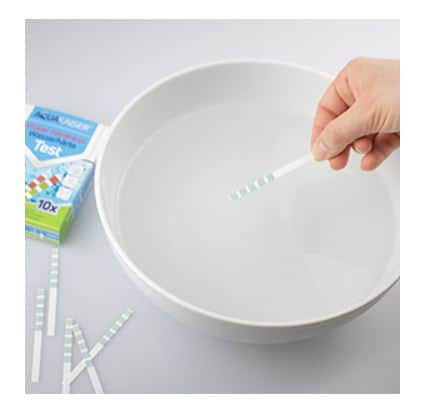
Essential index of chlorine in the water before adding pool cyanuric acid reducer
- Firstly, chlorine should be around 2 to 3 ppm.
- Otherwise, if it is above 5.0 ppm, leave the pool exposed to sunlight or use a chlorine neutralizer to reduce it.
Other parameters to check before adding pool cyanuric acid reducer
- In the first instance, the water temperature must be between the range of 20ºC to 40ºC.
- Secondarily, the pH level between 7,2 – 7,6
- Alkalinity between 80 – 150 ppm
- There should also be no presence of algae in the pool.
- At the same time, the copper level should not exceed 0,2 ppm.
- Lastly, no product such as algaecide or hydrogen peroxide should have been thrown into the water.
2ST STEP Lower the cyanuric acid in the pool with an acid reducer
Add a pool cyanuric acid reducer

What does the cyanuric acid reducer achieve?
Bioactive Cyanuric Acid Reducer is a naturally biodegradable product that works safely in your pool to reduce cyanuric acid levels.
It has been specifically designed to reduce cyanuric acid levels in swimming pools by over 100ppm.
Way to Add a Pool Cyanuric Acid Decreaser
- Initially, consult the label of the cyanuric acid reducer and based on the pool's requirement, calculate the portion of product required.
- In general terms, the dose consists of one sachet, which allows a reduction between 100 and 140 ppm in the isocyanuric level of a 50 m3 pool.
- Next, you spread the reducer into the skimmer of your pool.
Buy BioActivie acid reducer
BioActivie acid reducer price
[amazon box=»B00X8DJWWI» ]
3ST STEP Lower the cyanuric acid in the pool with an acid reducer
Filter the pool
- Next, you have to wait for a filter cycle until all the pool water has been filtered (normally it takes between 4-6 hours depending on the equipment).
4ST STEP Lower the cyanuric acid in the pool with an acid reducer
Check the results

- Test the pool water once the filter has been run to ensure that the cyanuric acid reducer has worked, remember that the values should range between 30-50ppm.
If you get a negative result, you must empty it and fill it with new water.
5ST STEP Lower the cyanuric acid in the pool with an acid reducer
Perform filter wash
Debug filtration system to remove cyanuric acid
Cyanuric acid from the pool can become impregnated in the filtration system, so according to the incidence itself and consequently the extremely high levels They can produce really complicated results, to the point that you have to change the filter.. So, it is worth doing a good wash and purifying the entire filtration system.
- Immediately, article link on the maintenance of the filters and where we show you how to wash the filtration system.
Video tutorial how to lower isocyanuric acid (CYA) in the pool
In summary, the video offered solves the issue of one of the most common problems in reference to water balance, this is having high cyanuric acid (CYA) in the pool.
Effectively learn to: How to lower the level of cyanuric acid in swimming pools.
How to remove cyanuric acid from pool water?
The cyanuric acid in the pool water is not eliminated, you must renew part of the water or empty it completely (depending on the saturation level of the pool).
If you choose to renew the water only partially, we recommend that you disinfect with active oxygen.
Check if cyanuric acid has decreased after it has rained

The amount of cyanuric acid drops after heavy rains
Check the quality of your pool water every week and after heavy rain.
The amount of cyanuric acid in your pool can change frequently as the water is filtered and diluted.
To keep cyanuric levels constant and avoid having to increase them, check levels at least once a week and after heavy rain.
If your cyanuric levels get too low, the sun's ultraviolet rays will destroy the chlorine in your pool and it will stop working. This will make your pool water more vulnerable to contaminants and give you a dirty pool.
- Cyanuric acid pool what is it
- Ideal Cyanuric Acid Levels
- Measure isocyanuric acid
- Why does your pool need cyanuric acid?
- Consequences of cyanuric acid imbalance in swimming pools
- How to adjust cyanuric acid values
- Stop the increase in high cyanuric acid in the pool
- Solution to lower pool cyanuric acid very high
- How to remove cyanuric acid from pool water?
- Check if cyanuric acid has decreased after it has rained
- How to slightly increase cyanuric acid in swimming pools
- How to increase cyanuric acid
How to slightly increase cyanuric acid in swimming pools
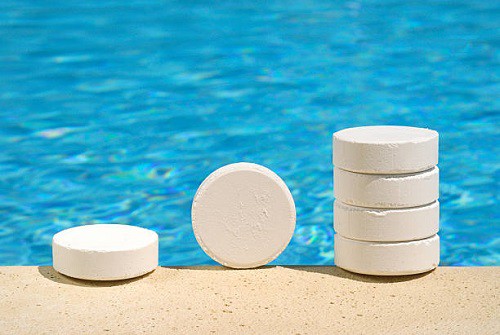
What is stabilized chlorine
Firstly, the stabilizing component combats the sun's ultraviolet rays because it prevents their destruction., achieving in this way that Chlorine remains in the water for longer.
Therefore, brings savings since we are going to reduce the amount of chlorine.
Furthermore, this element does not radically alter the acid level.
So, truly, It streamlines everything related to the maintenance and treatment of pool water.
Finally, claim that It is designed for all types of pools and/or coatings.
When to use stabilized chlorine
Now, mention that stabilized chlorine is used when the level of cyanuric acid requires an increase of less than 10 ppm).
How to use stabilized chlorine
- First, we calculate the necessary amount of product and if we need to raise or lower the pH or alkalinity we must add the product and wait for a filtering cycle so that it is adjusted (logically, before adding the stabilized chlorine).
- Secondly, and if necessary, after the pH or alkalinity adjustments have passed, we review the values again and check that everything is in order.
- On the other hand, in general terms, we could say that in most cases of stabilized chlorine products, about 4kg of product corresponds to every 100 m³ of water
- The product must be introduced with the purifier running and through the pump skimmer or prefilter.
- Subsequently, we must leave the pump in operation until it completes at least one filtration cycle (normally they are between 4-6 hours).
- In conclusion, We wait 48 hours and measure the values again and if necessary we repeat the process to readjust it.; Although, if you see that after 2 readjustments you have not achieved it, perhaps you should consider consulting a pool maintenance professional.
Especially, make reference to the fact that the portions are always subject and must be varied depending on multiple factors; the most important: according to the manufacturer of the product (always check the label!), the weather, pool characteristics, etc.
Buy stabilized chlorine
stabilized chlorine price
[amazon box=»B01IDLL4AW, B07GV19T7, B000NAOJT0, B06Y1S1H9Z» ]
What is chlorine stabilizer

Pool stabilizer to increase cyanuric acid in pools
In those cases where we need to raise cyanuric acid by more than 10ppm, we will proceed to add pool stabilizer.
The reason why the name pool stabilizer is derived is because Cyanuric acid stabilizes free chlorine so that it is not evaporated by the sun.
Combined format of isocyanuric acid swimming pool: stabilized chlorine
On the other hand, comment that it can also be mixed with chlorine tablets or bars, called trichlor, and in a chlorine shock, called dichlor. At the same time, These combined products are known as stabilized chlorine because the stabilizer mixes directly with the disinfectant, saving you the hassle of measuring and adding them separately.
Swimming pool isocyanuric acid sales format
- Sold in: liquid or granulated format separately or as an additive that can be placed in chlorine tablets.
Buy recommended chlorine stabilizer
Chlorine stabilizer price for swimming pools
[amazon box=»B07DQTPW3J, B07DHPBQZP, B08LZKCB26″ ]
How to increase cyanuric acid
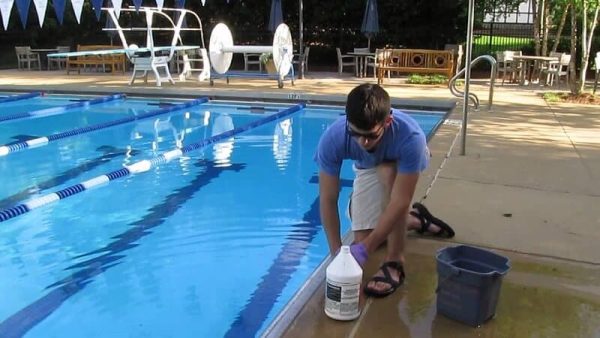
When cyanuric acid is added to the pool
When we use chlorine that is not stabilized, we will have to add the CYA separately to have a little more control over it.
When you need to add cyanuric acid to your pool
Such is the case that if you use this method, that is, adding cyanuric acid to the pool separately from chlorine, surely you should only incorporate it at a mandatory level in the set-up at the beginning of the season (or at most twice a year if you have adverse weather).
When you don't need to add cyanuric acid to your pool
If you are using a dichloro or trichloro type disinfectant (stabilized chlorine), in principle, you will not need more CYA (cyanuric acid pool).
Chemicals to raise pool isocyanide

Chemical compounds to increase isocyanuric acid in the pool: DICHLORINE
- This granular chemical compound, also called sodium dichloro-S-triazinetrione, contains chlorine and cyanuric acid, so you don't have to worry about adding additional cyanuric acid if you use it.
- Since it is granular, dichlor dissolves quite slowly.
- If you decide to add dichlor to your pool, a few words of warning: if you put it in a skimmer, be careful not to add too much too quickly, or you could end up blocking the lines.
Product to increase isocyanuric in swimming pools: TRICHLORO
- Trichloroisocyanuric acid is very similar to dichlor, except it comes in tablet or stick form that can be added to your erosion feeder.
- This organic compound should be added with a chlorinator, not with the skimmer or by pouring it directly into the pool.
Increase isocyanuric acid pools: LIQUID MUD
- Some cyanuric acid products are sold as liquid slurries rather than granular additives.
- Like dichlor, it is important to add the liquid suspension little by little to avoid clogging and staining.
- Start with a small amount and do not add another until the first is completely dissolved. Ideally, you want the cyanuric acid level in your pool to be between 30 and 50 parts per million (ppm).
- At that level, you should receive the most bang for your buck, making the chlorine last as long as possible.
- If the level is above 50 ppm, there are diminishing returns.
- Beyond that, you absolutely do not want your cyanuric acid levels to exceed 100 ppm.
How to add cyanuric acid to the pool

Steps to add cyanuric acid to your pool
- To begin, we calculate the necessary amount of product and if we need to raise or lower the pH or alkalinity we must add the product and wait for a filtering cycle so that it is adjusted (logically, before adding the stabilized chlorine).
- If the first point was necessary, after the pH or alkalinity adjustments have passed, we review the values again and check that everything is in order.
- On the other hand, get a bucket of more or less 20L and we will fill it halfway with warm water.
- IMPORTANT: (and never skip it!) Equip yourself with protective glasses and acid-resistant gloves.
- Next, we will consult the product label and according to the need we will mix the required dose of cyanuric acid inside the cube. Generally, to increase 10 ppm of CYA in a 100m3 pool, about 13 tablespoons of cyanuric acid are added.
- Next, we wait about 10 minutes for it to be completely dissolved.
- As always when we add a chemical product, the operation will be carried out with the purifier running and through the skimmer basket or pump prefilter.
- We leave the pump running until it completes at least one filtering cycle. (normally they are between 4-6 hours).
- In conclusion, We wait 48 hours and measure the values again and if necessary we repeat the process to readjust it.; Although, if you see that after 2 readjustments you have not achieved it, perhaps you should consider consulting a pool maintenance professional.
